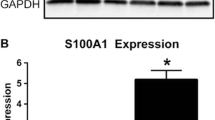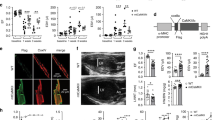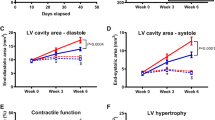Abstract
Melusin is a muscle-specific protein which interacts with β1 integrin cytoplasmic domain and acts as chaperone protein. Its overexpression induces improved resistance to cardiac overload delaying left ventricle dilation and reducing the occurrence of heart failure. Here, we investigated possible protective effect of melusin overexpression against acute ischemia/reperfusion (I/R) injury with or without Postconditioning cardioprotective maneuvers. Melusin transgenic (Mel-TG) mice hearts were subjected to 30-min global ischemia followed by 60-min reperfusion. Interestingly, infarct size was reduced in Mel-TG mice hearts compared to wild-type (WT) hearts (40.3 ± 3.5 % Mel-TG vs. 59.5 ± 3.8 % WT hearts; n = 11 animals/group; P < 0.05). The melusin protective effect was also demonstrated by measuring LDH release, which was 50 % lower in Mel-TG compared to WT. Mel-TG hearts had a higher baseline level of AKT, ERK1/2 and GSK3β phosphorylation, and displayed increased phospho-kinases level after I/R compared to WT mice. Post-ischemic Mel-TG hearts displayed also increased levels of the anti-apoptotic factor phospho-BAD. Importantly, pharmacological inhibition of PI3K/AKT (Wortmannin) and ERK1/2 (U0126) pathways abrogated the melusin protective effect. Notably, HSP90, a chaperone known to protect heart from I/R injury, showed high levels of expression in the heart of Mel-TG mice suggesting a possible collaboration of this molecule with AKT/ERK/GSK3β pathways in the melusin-induced protection. Postconditioning, known to activate AKT/ERK/GSK3β pathways, significantly reduced IS and LDH release in WT hearts, but had no additive protective effects in Mel-TG hearts. These findings implicate melusin as an enhancer of AKT and ERK pathways and as a novel player in cardioprotection from I/R injury.




Similar content being viewed by others
References
Baines CP (2009) The mitochondrial permeability transition pore and ischemia-reperfusion injury. Basic Res Cardiol 104:181–188. doi:10.1007/s00395-009-0004-8
Baker JE (2004) Oxidative stress and adaptation of the infant heart to hypoxia and ischemia. Antioxid Redox Signal 6:423–429. doi:10.1089/152308604322899495
Basso AD, Solit DB, Chiosis G, Giri B, Tsichlis P, Rosen N (2002) Akt forms an intracellular complex with heat shock protein 90 (Hsp90) and Cdc37 and is destabilized by inhibitors of Hsp90 function. J Biol Chem 277:39858–39866. doi:10.1074/jbc.M206322200
Bell RM, Mocanu MM, Yellon DM (2011) Retrograde heart perfusion: the Langendorff technique of isolated heart perfusion. J Mol Cell Cardiol 50:940–950. doi:10.1016/j.yjmcc.2011.02.018
Bencsik P, Pálóczi J, Kocsis GF, Pipis J, Belecz I, Varga ZV, Csonka C, Görbe A, Csont T, Ferdinandy P (2014) Moderate inhibition of myocardial matrix metalloproteinase-2 by ilomastat is cardioprotective. Pharmacol Res 80:36–42. doi:10.1016/j.phrs.2013.12.007
Bergmeyer HU, Bernt E (1974) UV-assay with pyruvate and NADH. In: Bergmeyer HU (ed) Methods of enzymatic analysis, vol II, 2nd edn. Academic Press, New York, pp 574–579
Bolli R, Bhatti ZA, Tang XL, Qiu Y, Zhang Q, Guo Y, Jadoon AK (1997) Evidence that late preconditioning against myocardial stunning in conscious rabbits is triggered by the generation of nitric oxide. Circ Res 81:42–52. doi:10.1161/01.RES.81.1.42
Brancaccio M, Fratta L, Notte A, Hirsch E, Poulet R, Guazzone S, De Acetis M, Vecchione C, Marino G, Altruda F, Silengo L, Tarone G, Lembo G (2003) Melusin, a muscle-specific integrin beta1-interacting protein, is required to prevent cardiac failure in response to chronic pressure overload. Nat Med 9:68–75. doi:10.1038/nm805
Budas GR, Churchill EN, Disatnik MH, Sun L, Mochly-Rosen D (2010) Mitochondrial import of PKCepsilon is mediated by HSP90: a role in cardioprotection from ischaemia and reperfusion injury. Cardiovasc Res 88:83–92. doi:10.1093/cvr/cvq154
Bulhak AA, Jung C, Ostenson CG, Lundberg JO, Sjöquist PO, Pernow J (2009) PPAR-alpha activation protects the type 2 diabetic myocardium against ischemia-reperfusion injury: involvement of the PI3-Kinase/Akt and NO pathway. Am J Physiol Heart Circ Physiol 296:H719–H727. doi:10.1152/ajpheart.00394.2008
Chen Z, Chua CC, Ho YS, Hamdy RC, Chua BH (2001) Over-expression of Bcl-2 attenuates apoptosis and protects against myocardial I/R injury in transgenic mice. Am J Physiol 280:H2313–H2320
Choudhury S, Bae S, Ke Q, Lee JY, Kim J, Kang PM (2011) Mitochondria to nucleus translocation of AIF in mice lacking Hsp70 during ischemia/reperfusion. Basic Res Cardiol 106:397–407. doi:10.1007/s00395-011-0164-1
Cohen MV, Downey JM (2011) Ischemic postconditioning: from receptor to end-effector. Antioxid Redox Signal 14:821–831. doi:10.1089/ars.2010.3318
Darling CE, Jiang R, Maynard M, Whittaker P, Vinten-Johansen J, Przyklenk K (2005) ‘Postconditioning’ via stuttering reperfusion limits myocardial infarct size in rabbit hearts: role of ERK 1/2. Am J Physiol Heart Circ Physiol 289:H1618–H1626. doi:10.1152/ajpheart.00055.2005
De Acetis M, Notte A, Accornero F, Selvetella G, Brancaccio M, Vecchione C, Sbroggiò M, Collino F, Pacchioni B, Lanfranchi G, Aretini A, Ferretti R, Maffei A, Altruda F, Silengo L, Tarone G, Lembo G (2005) Cardiac overexpression of melusin protects from dilated cardiomyopathy due to long-standing pressure overload. Circ Res 96:1087–1094. doi:10.1161/01.RES.0000168028.36081.e0
Dent P (2014) Crosstalk between ERK, AKT, and cell survival. Cancer Biol Ther 15:245–246. doi:10.4161/cbt.27541
Eeftting F, Rensing B, Wigman J, Pannekoek WJ, Liu WM, Cramer MJ, Lips DJ, Doevendans PA (2004) Role of apoptosis in reperfusion injury. Cardiovasc Res 61:414–426. doi:10.1016/j.cardiores.2003.12.023
Efthymiou CA, Mocanu MM, de Belleroche J, Wells DJ, Latchmann DS, Yellon DM (2004) Heat shock protein 27 protects the heart against myocardial infarction. Basic Res Cardiol 99:392–394. doi:10.1007/s00395-004-0483-6
Engelman DT, Watanabe M, Engelman RM, Rousou JA, Kisin E, Kagan VE, Maulik N, Das DK (1995) Hypoxic preconditioning preserves antioxidant reserve in the working rat heart. Cardiovasc Res 29:133–140. doi:10.1016/S0008-6363(96)88558-0
Ferretti R, Sbroggiò M, Di Savino A, Fusella F, Bertero A, Michowski W, Tarone G, Brancaccio M (2011) Morgana and melusin: two fairies chaperoning signal transduction. Cell Cycle 10:3678–3683. doi:10.4161/cc.10.21.18202
Gottlieb RA, Burleson KO, Kloner RA, Babior BM, Engler RL (1994) Reperfusion injury induces apoptosis in rabbit cardiomyocytes. J Clin Invest 94:1621–1628. doi:10.1172/JCI117504
Gu R, Zheng D, Bai J, Xie J, Dai Q, Xu B (2012) Altered melusin pathways involved in cardiac remodeling following acute myocardial infarction. Cardiovasc Pathol 21:105–111. doi:10.1016/j.carpath.2011.03.002
Halkos ME, Kerendi F, Corvera JS, Wang NP, Kin H, Payne CS, Sun HY, Guyton RA, Vinten-Johansen J, Zhao ZQ (2004) Myocardial protection with postconditioning is not enhanced by ischemic preconditioning. Ann Thorac Surg 78:961–969. doi:10.1016/j.athoracsur.2004.03.033 discussion 969
Hausenloy DJ, Lecour S, Yellon DM (2011) Reperfusion injury salvage kinase and survivor activating factor enhancement prosurvival signaling pathways in ischemic postconditioning: two sides of the same coin. Antioxid Redox Signal 14:893–907. doi:10.1089/ars.2010.3360
Hausenloy DJ, Ong SB, Yellon DM (2009) The mitochondrial permeability transition pore as a target for preconditioning and postconditioning. Basic Res Cardiol 104:189–202. doi:10.1007/s00395-009-0010-x
Hausenloy DJ, Tsang A, Mocanu MM, Yellon DM (2005) Ischemic preconditioning protects by activating prosurvival kinases at reperfusion. Am J Physiol Heart Circ Physiol 288:H971–H976. doi:10.1152/ajpheart.00374.2004
Hausenloy DJ, Tsang A, Yellon DM (2005) The reperfusion injury salvage kinase pathway: a common target for both ischemic preconditioning and postconditioning. Trends Cardiovasc Med 15:69–75
Heusch G (2013) Remote conditioning: the future of cardioprotection? J Cardiovasc Med (Hagerstown) 14:176–179. doi:10.2459/JCM.0b013e328358e507
Heusch G (2013) Cardioprotection: chances and challenges of its translation to the clinic. Lancet 381:166–175. doi:10.1016/S0140-6736(12)60916-7
Heusch G, Boengler K, Schulz R (2008) Cardioprotection: nitric oxide, protein kinases, and mitochondria. Circulation 118:1915–1919. doi:10.1161/CIRCULATIONAHA.108.805242
Heusch G, Musiolik J, Gedik N, Skyschally A (2011) Mitochondrial STAT3 activation and cardioprotection by ischemic postconditioning in pigs with regional myocardial ischemia/reperfusion. Circ Res 109:1302–1308. doi:10.1161/CIRCRESAHA.111.255604
Hong TJ, Kim S, Wi AR, Lee P, Kang M, Jeong JH, Hahn JS (2013) Dynamic nucleotide-dependent interactions of cysteine- and histidine-rich domain (CHORD)-containing Hsp90 cochaperones Chp-1 and melusin with cochaperones PP5 and Sgt1. J Biol Chem 288:215–222. doi:10.1074/jbc.M112.398636
Iliodromitis EK, Karavolias GK, Bofilis E, Yellon DM, Kremastinos DT (1999) Enhanced protection of heat shock in myocardial infarction: inhibition of detrimental effect of systemic hyperthermia. Cardiovasc Drugs Ther 13:223–231. doi:10.1023/A:1007796125902
Kingma JG Jr (1999) Cardiac adaptation to ischemia-reperfusion injury. Ann N Y Acad Sci 874:83–99. doi:10.1111/j.1749-6632.1999.tb09227.x1
Kupatt C, Dessy C, Hinkel R, Raake P, Daneau G, Bouzin C, Boekstegers P, Feron O (2004) Heat shock protein 90 transfection reduces ischemia-reperfusion-induced myocardial dysfunction via reciprocal endothelial NO synthase serine 1177 phosphorylation and threonine 495 dephosphorylation. Arterioscler Thromb Vasc Biol 24:1435–1441. doi:10.1161/01.ATV.0000134300.87476.d1
Lacerda L, Somers S, Opie LH, Lecour S (2009) Ischaemic postconditioning protects against reperfusion injury via the SAFE pathway. Cardiovasc Res 84:201–208. doi:10.1093/cvr/cvp274
Lavu M, Gundewar S, Lefer DJ (2011) Gene therapy for ischemic heart disease. J Mol Cell Cardiol 50:742–750. doi:10.1016/j.yjmcc.2010.06.007
Liu Y, Yang XM, Iliodromitis EK, Kremastinos DT, Dost T, Cohen MV, Downey JM (2008) Redox signaling at reperfusion is required for protection from ischemic preconditioning but not from a direct PKC activator. Basic Res Cardiol 103:54–59. doi:10.1007/s00395-007-0683-y
Logue SE, Gustafsson AB, Samali A, Gottlieb RA (2005) Ischemia/reperfusion injury at the intersection with cell death. J Mol Cell Cardiol 38:21–33. doi:10.1016/j.yjmcc.2004.11.009
Luan HF, Zhao ZB, Zhao QH, Zhu P, Xiu MY, Ji Y (2012) Hydrogen sulfide postconditioning protects isolated rat hearts against ischemia and reperfusion injury mediated by the JAK2/STAT3 survival pathway. Braz J Med Biol Res 45:898–905. doi:10.1590/S0100-879X2012007500090
Marais E, Genade S, Salie R, Huisamen B, Maritz S, Moolman JA, Lochner A (2005) The temporal relationship between p38 MAPK and HSP27 activation in ischaemic and pharmacological preconditioning. Basic Res Cardiol 100:35–47. doi:10.1007/s00395-004-0495-7
Marber MS, Latchman DS, Walker JM, Yellon DM (1993) Cardiac stress protein elevation 24 hours after brief ischemia or heat stress is associated with resistance to myocardial infarction. Circulation 88:1264–1272. doi:10.1161/01.CIR.88.3.1264
Maulik N, Watanabe M, Engelman DT, Engelman RM, Das DK (1995) Oxidative stress adaptation improves postischemic ventricular recovery. Mol Cell Biochem 144:67–74. doi:10.1007/BF00926742
Mavria G, Vercoulen Y, Yeo M, Paterson H, Karasarides M, Marais R, Bird D, Marshall CJ (2006) ERK-MAPK signaling opposes Rho-kinase to promote endothelial cell survival and sprouting during angiogenesis. Cancer Cell 9:33–44. doi:10.1016/j.ccr.2005.12.021
Murry CE, Jennings RB, Reimer KA (1986) Preconditioning with ischemia: a delay of lethal cell injury in ischemic myocardium. Circulation 74:1124–1136. doi:10.1161/01.CIR.74.5.1124
Okubo S, Wildner O, Shah MR, Chelliah JC, Hess ML, Kukreja RC (2001) Gene transfer of heat-shock protein 70 reduces infarct size in vivo after ischemia/reperfusion in the rabbit heart. Circulation 103:877–881. doi:10.1161/01.CIR.103.6.877
Pagliaro P, Gattullo D, Rastaldo R, Losano G (2001) Ischemic preconditioning: from the first to the second window of protection. Life Sci 69:1–15
Pagliaro P, Moro F, Tullio F, Perrelli MG, Penna C (2011) Cardioprotective pathways during reperfusion: focus on redox signaling and other modalities of cell signaling. Antioxid Redox Signal 14:833–850. doi:10.1089/ars.2010.3245
Penna C, Cappello S, Mancardi D, Raimondo S, Rastaldo R, Gattullo D, Losano G, Pagliaro P (2006) Post-conditioning reduces infarct size in the isolated rat heart: role of coronary flow and pressure and the nitric oxide/cGMP pathway. Basic Res Cardiol 101:168–179. doi:10.1007/s00395-005-0543-6
Penna C, Perrelli MG, Pagliaro P (2013) Mitochondrial pathways, permeability transition pore, and redox signaling in cardioprotection: therapeutic implications. Antioxid Redox Signal 18:556–599. doi:10.1089/ars.2011.4459
Penna C, Tullio F, Merlino A, Moro F, Raimondo S, Rastaldo R, Perrelli MG, Mancardi D, Pagliaro P (2009) Postconditioning cardioprotection against infarct size and post-ischemic systolic dysfunction is influenced by gender. Basic Res Cardiol 104:390–402. doi:10.1007/s00395-008-0762-8
Philipp S, Critz SD, Cui L, Solodushko V, Cohen MV, Downey JM (2006) Localizing extracellular signal-regulated kinase (ERK) in pharmacological preconditioning’s trigger pathway. Basic Res Cardiol 101:159–167. doi:10.1007/s00395-005-0566-z
Prasad MR, Liu X, Rousou JA, Engelman RM, Jones R, George A, Das DK (1992) Reduced free radical generation during reperfusion of hypothermically arrested hearts. Mol Cell Biochem 111:97–102. doi:10.1007/BF002295791
Sato S, Fujita N, Tsuruo T (2000) Modulation of Akt kinase activity by binding to HSP90. Proc Natl Acad Sci USA 97:10832–10837. doi:10.1073/pnas.170276797
Sbroggiò M, Bertero A, Velasco S, Fusella F, De Blasio E, Bahou WF, Silengo L, Turco E, Brancaccio M, Tarone G (2011) ERK1/2 activation in heart is controlled by melusin, focal adhesion kinase and the scaffold protein IQGAP1. J Cell Sci 124:3515–3524. doi:10.1242/jcs.091140
Sbroggiò M, Carnevale D, Bertero A, Cifelli G, De Blasio E, Mascio G, Hirsch E, Bahou WF, Turco E, Silengo L, Brancaccio M, Lembo G, Tarone G (2011) IQGAP1 regulates ERK1/2 and AKT signalling in the heart and sustains functional remodelling upon pressure overload. Cardiovasc Res 91:456–464. doi:10.1093/cvr/cvr103
Sbroggiò M, Ferretti R, Percivalle E, Gutkowska M, Zylicz A, Michowski W, Kuznicki J, Accornero F, Pacchioni B, Lanfranchi G, Hamm J, Turco E, Silengo L, Tarone G, Brancaccio M (2008) The mammalian CHORD-containing protein melusin is a stress response protein interacting with Hsp90 and Sgt1. FEBS Lett 582:1788–1794. doi:10.1016/j.febslet.2008.04.058
Schulz R, Rose J, Post H, Heusch G (1995) Involvement of endogenous adenosine in ischaemic preconditioning in swine. Pflugers Arch 430:273–282. doi:10.1007/BF00374659
Shaul YD, Seger R (2007) The MEK/ERK cascade: from signaling specificity to diverse functions. Biochim Biophys Acta 1773(8):1213–1226. doi:10.1016/j.bbamcr.2006.10.005
Sivaraman V, Mudalagiri NR, Di Salvo C, Kolvekar S, Hayward M, Yap J, Keogh B, Hausenloy DJ, Yellon DM (2007) Postconditioning protects human atrial muscle through the activation of the RISK pathway. Basic Res Cardiol 102:453–459. doi:10.1007/s00395-007-0664-1
Skyschally A, Van Caster P, Boengler K, Gres P, Musiolik J, Schilawa D, Schulz R, Heusch G (2009) Ischemic postconditioning in pigs: no causal role for RISK activation. Circ Res 104:15–18. doi:10.1161/CIRCRESAHA.108.186429
Skyschally A, van Caster P, Iliodromitis EK, Schulz R, Kremastinos DT, Heusch G (2009) Ischemic postconditioning: experimental models and protocol algorithms. Basic Res Cardiol 104:469–483. doi:10.1007/s00395-009-0040-4
Suzuki K, Sawa Y, Kagisaki K, Taketani S, Ichikawa H, Kaneda Y, Matsuda H (2000) Reduction in myocardial apoptosis associated with overexpression of heat shock protein 70. Basic Res Cardiol 95:397–403. doi:10.1007/s003950070039
Tarone G, Sbroggiò M, Brancaccio M (2013) Key role of ERK1/2 molecular scaffolds in heart pathology. Cell Mol Life Sci 70:4047–4054. doi:10.1007/s00018-013-1321-5
Unsöld B, Kaul A, Sbroggiò M, Schubert C, Regitz-Zagrosek V, Brancaccio M, Damilano F, Hirsch E, van Bilsen M, Munts C, Sipido K, Bito V, Detre E, Wagner NM, Schäfer K, Seidler T, Vogt J, Neef S, Bleckmann A, Maier LS, Balligand JL, Bouzin C, Clapier RV, Garnier A, Eschenhagen T, El-Armouche A, Knöll R, Tarone G, Hasenfuß G (2013) Melusin protects from cardiac rupture and improves functional remodelling after myocardial infarction. Cardiovasc Res. doi:10.1093/cvr/cvt235
Vinten-Johansen J, Granfeldt A, Mykytenko J, Undyala VV, Dong Y, Przyklenk K (2011) The multidimensional physiological responses to postconditioning. Antioxid Redox Signal 14:791–810. doi:10.1089/ars.2010.3396
Vinten-Johansen J, Zhao ZQ, Zatta AJ, Kin H, Halkos ME, Kerendi F (2005) Postconditioning-A new link in nature’s armor against myocardial ischemia-reperfusion injury. Basic Res Cardiol 100:295–310. doi:10.1007/s00395-005-0539-2
Waardenberg AJ, Bernardo BC, Ng DC, Shepherd PR, Cemerlang N, Sbroggiò M, Wells CA, Dalrymple BP, Brancaccio M, Lin RC, McMullen JR (2011) Phosphoinositide 3-kinase (PI3K(p110alpha)) directly regulates key components of the Z-disc and cardiac structure. J Biol Chem 286:30837–30846. doi:10.1074/jbc.M111.271684
Willis MS, Patterson C (2010) Hold me tight: role of the heat shock protein family of chaperones in cardiac disease. Circulation 122:1740–1751. doi:10.1161/CIRCULATIONAHA.110.942250
Zhang J, Cai H (2010) Netrin-1 prevents ischemia/reperfusion-induced myocardial infarction via a DCC/ERK1/2/eNOS s1177/NO/DCC feed-forward mechanism. J Mol Cell Cardiol 48:1060–1070. doi:10.1016/j.yjmcc.2009.11.020
Zhao ZQ, Nakamura M, Wang NP, Wilcox JN, Shearer S, Ronson RS, Guyton RA, Vinten-Johansen J (2000) Reperfusion induces myocardial apoptotic cell death. Cardiovasc Res 45:651–660. doi:10.1016/S0008-6363(99)00354-5
Acknowledgments
This work was supported by funding from Telethon grant GGP12047 to GT, MIUR Prin 2010RNXM9C_002 to GT; MIUR PRIN 2010J8RYS7_007 to MB and ex-60 % to PP.
Conflict of interest
Mara Brancaccio and Guido Tarone are scientific cofounders and consultants for Target Heart Biotec, a company that develops melusin recombinant protein as a drug to counteract heart failure.
Author information
Authors and Affiliations
Corresponding author
Additional information
C. Penna, M. Brancaccio, P. Pagliaro, and G. Tarone contributed equally to this work.
Rights and permissions
About this article
Cite this article
Penna, C., Brancaccio, M., Tullio, F. et al. Overexpression of the muscle-specific protein, melusin, protects from cardiac ischemia/reperfusion injury. Basic Res Cardiol 109, 418 (2014). https://doi.org/10.1007/s00395-014-0418-9
Received:
Revised:
Accepted:
Published:
DOI: https://doi.org/10.1007/s00395-014-0418-9




